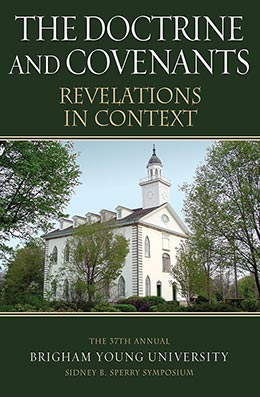Preface
“Preface,” in The Doctrine and Covenants: Revelations in Context, ed. Andrew H. Hedges, J. Spencer Fluhman, and Alonzo L. Gaskill (Provo and Salt Lake City: Religious Studies Center, Brigham Young University, and Deseret Book, 2008) vii–viii.
As the capstone of our religion, the Doctrine and Covenants provides insights to the restored gospel of Jesus Christ not found in any other of the standard works. Here we can find detailed information about priesthood offices, Church organization, the Millennium, consecration, and a host of other topics only hinted at elsewhere, and we would be hardpressed to quibble with the idea that the Doctrine and Covenants is “a book of answers” to modern questions. It is easy to forget that the revelations that make up this book of scripture, like all revelations, were received in response to specific questions asked by real people at specific points in time, placing it in the larger historical and cultural backdrop of nineteenth—century America. It is easy to forget, too, that just like the New Testament or Book of Mormon, the Doctrine and Covenants has a rich textual history, and the form in which we find the revelations today is the product of a complex process of revelation, recording, editing, publication, and prophetic revision that continues today.
While we need not be aware of the revelations’ settings and textual development to learn important truths from the Doctrine and Covenants, such awareness enhances our appreciation for the revelations and for the prophets through whom they came. It also draws our attention to important truths we might otherwise miss and helps us better understand and more appropriately apply the revelations in our personal lives. Furthermore, an awareness of the background of Joseph Smith’s revelations allows us to better understand their significance.
This collection of essays is designed to help members of the Church begin to do precisely that. The articles, written by scholars trained in a variety of fields, provide insight to the historical, cultural, religious, and textual backgrounds of select revelations. They are intended to help Latter-day Saints better appreciate the setting in which Joseph received his revelations and to make them aware of the types of things that can be learned through a careful study of each revelation’s background. It must be emphasized that no attempt has been made to provide a comprehensive overview of the background and development of each revelation or of the Doctrine and Covenants as a whole; our overall approach has been to look in depth at a few sections rather than to provide a broader, less—detailed overview. Each essay, correspondingly, stands largely on its own, and should not be considered a chapter in a larger and developing theme or argument of the entire volume.
The variety of approaches the authors have taken testifies of the richness of the revelations’ texts and contexts, and to the number and types of questions that might be asked of them. One also sees in these essays the influence of various Church- and BYU-sponsored research projects, such as the Joseph Smith Papers Project and Scott H. Faulring, Kent P. Jackson, and Robert J. Matthews’s critical text of Joseph Smith’s New Translation of the Bible. The increasing attention Joseph has received at the hands of non-LDS scholars in recent years is also evident. One sees in these essays the fruit of an unprecedented level of scholarly inquiry into the life and times of Joseph Smith and scholars’ belated recognition of his importance in the history of American culture, society, and religion. Our hope as editors is that this collection of essays, written from the combined perspectives of faith and scholarship, will prove an important addition to this growing body of research into the life and thought of the Prophet of the Restoration and will help readers better understand and appreciate the significant roles Joseph Smith’s revelations have played, and continue to play, in the dispensation of the fulness of times.
